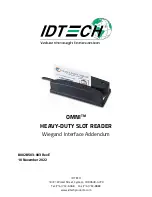
Operating Instructions
MS1300P
Manure Spreader
26
5.
Start the tractor and leave it at a low idle.
6.
Slowly engage the PTO.
7.
Do one of the following:
-
If the beater bar turns freely, continue spreading.
-
If the beater bar fails to turn, continue with Step 8.
8.
Disengage the PTO, apply the parking brake, and then turn
off the tractor.
9.
Inspect the following apron chain locations for an
obstruction or damage:
-
Inside the main box
-
Main box undercarriage
-
Front and rear sprockets
10.
If the apron drive and chain appear to be in working order,
repeat Steps 5 and 6, and then continue with Step 11.
11.
Do one of the following:
-
If the beater bar and paddles turn freely, continue
spreading.
-
If the beater bar and paddles fail to turn, repeat Step 8,
and then manually unload the manure spreader to find
the blockage.
8.10 Transporting
IMPORTANT! Equipment that is transported on a public
roadway must comply with the local laws that govern the
safety and transport of machinery.
The manure spreader is not intended for use or transport on
public roadways. Therefore, it does not include the required
lights, reflectors, and markings.
Before taking the manure spreader on a public roadway,
install the required lighting, reflectors, and markings, and
make sure that they are in good working condition.
For specific requirements, contact your local transportation
authority.
8.10.1 Transport Safety
•
Never allow riders on the manure spreader.
•
Do not exceed a safe travel speed. Slow down for rough
terrain and cornering.
•
Make sure that the spreader is securely hitched to the
tractor and that a retainer is through the drawbar. Always
attach a safety chain between the hitch and the tractor.
8.10.2 Before Transporting the Manure
Spreader
Check each of the following:
•
PTO is disengaged.
•
Trailer jack is raised and locked in position.
•
Tire pressure is correct. If required, inflate the tires to the
pressure that is specified on the tire sidewall.
•
Tires and rims are in good condition. Replace a cut tire or
repair damaged rims.
•
Lug nuts are tight. Tighten loose lug nuts to the required
torque. For torque specifications, see
•
Axle dust caps are in good condition. Replace axle dust
caps that are damaged or leaking.
















































